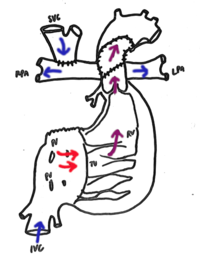
Photo from wikipedia
OBJECTIVES Large data sets have been published on short- and long-term outcomes following bidirectional Glenn surgery (BDG), or partial cavopulmonary connection, in high-income countries. Data from low-income and middle-income countries… Click to show full abstract
OBJECTIVES Large data sets have been published on short- and long-term outcomes following bidirectional Glenn surgery (BDG), or partial cavopulmonary connection, in high-income countries. Data from low-income and middle-income countries are few and often limited to the immediate postoperative period. The primary outcome was any in-hospital postoperative complication, assessed according to predefined criteria, in children who underwent BDG surgery at Red Cross War Memorial Children's Hospital. DESIGN A retrospective cohort study. SETTING A tertiary teaching hospital. PARTICIPANTS The study authors identified 61 children (<18 years of age) who underwent BDG over 8 years. The median age of patients undergoing BDG was 2.5 years (interquartile range, 1.4-5.5 years). INTERVENTIONS BDG surgery. MEASUREMENTS AND MAIN RESULTS Thirty-five patients (57.4%) had a postoperative complication, with some patients (17 of 61, 27.9%) having more than 1 complication. The most frequent complications were infective (29.5%). Univariate analysis found that postoperative complications were associated with the use of nitric oxide (p = 0.004) and a longer duration of anesthesia (p = 0.045) and surgery (p = 0.004). Patients with complications spent longer in the pediatric intensive care unit (ICU) (p < 0.001) and in the hospital (p < 0.012). On multivariate analysis, a priori risk factors based on previous studies were not found to be statistically significant. A total of 37.3% of patients completed their single-ventricle palliation, and 30.5% of patients were lost to follow-up. CONCLUSIONS Important findings were the older age at which the BDG was performed compared to high-income countries, an acceptable mortality rate of 3.3%, infection being the most common complication, the association of a complication with increased ICU and hospital lengths of stay, and the high rate of patients lost to follow-up.
Journal Title: Journal of cardiothoracic and vascular anesthesia
Year Published: 2022
Link to full text (if available)
Share on Social Media: Sign Up to like & get
recommendations!